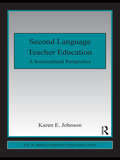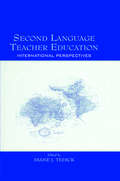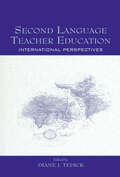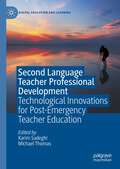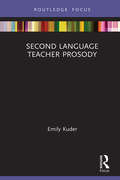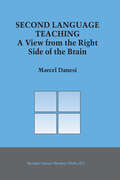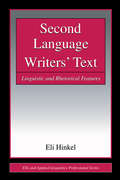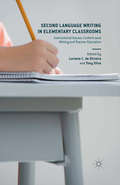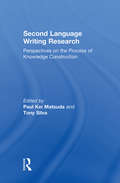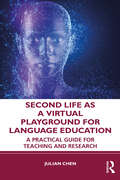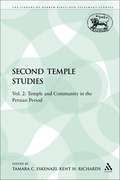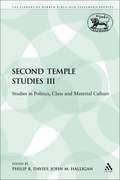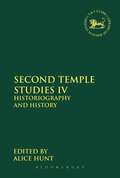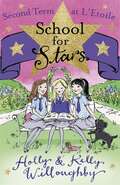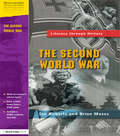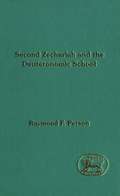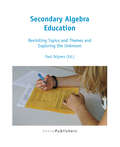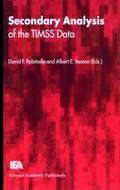- Table View
- List View
Second Language Teacher Education: A Sociocultural Perspective (PDF)
by Karen E. JohnsonThis book presents a comprehensive overview of the epistemological underpinnings of a sociocultural perspective on human learning and addresses in detail what this perspective has to offer the field of second language teacher education.
Second Language Teacher Education: A Sociocultural Perspective (ESL & Applied Linguistics Professional Series)
by Karen E. Johnson'… A beautifully written, articulate and compelling argument for a sociocultural perspective on second language teacher education . . . Essential reading for all who wish to understand this perspective.' – David Nunan, University of Hong Kong '…Significant and timely. Johnson is masterful at writing in an engaging, transparent prose about complex concepts. It’s a rare scholar who can write prose like this. Throughout my reading I wanted to engage in dialogue with her – this is a sure sign of a great book." – Diane Tedick, University of Minnesota, USA This book presents a comprehensive overview of the epistemological underpinnings of a sociocultural perspective on human learning and addresses in detail what this perspective has to offer the field of second language teacher education. Captured through five changing points of view, it argues that a sociocultural perspective on human learning changes the way we think about how teachers learn to teach, how teachers think about language, how teachers teach second languages, the broader social, cultural, and historical macro-structures that are ever present and ever changing in the second language teaching profession, and what constitutes second language teacher professional development. Overall, it clearly and accessibly makes the case that a sociocultural perspective on human learning reorients how the field understands and supports the professional development of second language teachers.
Second Language Teacher Education: A Sociocultural Perspective (ESL & Applied Linguistics Professional Series)
by Karen E. Johnson'… A beautifully written, articulate and compelling argument for a sociocultural perspective on second language teacher education . . . Essential reading for all who wish to understand this perspective.' – David Nunan, University of Hong Kong '…Significant and timely. Johnson is masterful at writing in an engaging, transparent prose about complex concepts. It’s a rare scholar who can write prose like this. Throughout my reading I wanted to engage in dialogue with her – this is a sure sign of a great book." – Diane Tedick, University of Minnesota, USA This book presents a comprehensive overview of the epistemological underpinnings of a sociocultural perspective on human learning and addresses in detail what this perspective has to offer the field of second language teacher education. Captured through five changing points of view, it argues that a sociocultural perspective on human learning changes the way we think about how teachers learn to teach, how teachers think about language, how teachers teach second languages, the broader social, cultural, and historical macro-structures that are ever present and ever changing in the second language teaching profession, and what constitutes second language teacher professional development. Overall, it clearly and accessibly makes the case that a sociocultural perspective on human learning reorients how the field understands and supports the professional development of second language teachers.
Second Language Teacher Education: International Perspectives
by Diane J. TedickThe education of second language teachers takes place across diverse contexts, levels, settings, and geographic regions. By bringing together research, theory, and best practices from a variety of contexts (ESL/EFL, foreign language, bilingual and immersion education), this book contributes to building meaningful professional dialogue among second-language teacher educators. Featuring an international roster of authors, the volume is comprised of 18 chapters organized in four thematic sections: the knowledge base of second language teacher education; second language teacher education contexts; collaborations in second language teacher education; and second language teacher education in practice. Second Language Teacher Education: International Perspectives is an essential professional resource for practicing and prospective second language teacher educators around the world.
Second Language Teacher Education: International Perspectives
by Diane J. TedickThe education of second language teachers takes place across diverse contexts, levels, settings, and geographic regions. By bringing together research, theory, and best practices from a variety of contexts (ESL/EFL, foreign language, bilingual and immersion education), this book contributes to building meaningful professional dialogue among second-language teacher educators. Featuring an international roster of authors, the volume is comprised of 18 chapters organized in four thematic sections: the knowledge base of second language teacher education; second language teacher education contexts; collaborations in second language teacher education; and second language teacher education in practice. Second Language Teacher Education: International Perspectives is an essential professional resource for practicing and prospective second language teacher educators around the world.
Second Language Teacher Professional Development: Technological Innovations for Post-Emergency Teacher Education (Digital Education and Learning)
by Karim Sadeghi Michael ThomasThis edited book brings together documented evidence and theoretical propositions on the essential mediating role of digital technology in L2 teacher education and professional development. Topics range from technological affordances in teacher education, to challenges and responses to emergency transition from face to face to virtual professional development, to successful practices of online teacher training courses. Bringing together examples from various countries and contexts of how L2 teacher trainers and trainee teachers view these forced changes and react to them, the volume fills a gap in the use of digital technology in contexts where teacher educators and trainee teachers are not technology-literate and not prepared for technology-oriented education. In addition to a Foreword by Mark Warschauer and Introduction and Conclusion chapters by Editors, the volume features 13 full-length chapters by some of the well-known experts from countries such as Australia, Finland, Mexico, the UK, the USA, Spain, Singapore, Turkey and Sweden.
Second Language Teacher Prosody
by Emily KuderSecond Language Teacher Prosody focuses on the prosodic characteristics of input in L2 Spanish classrooms. Readers are led through descriptions and interpretations of prosodic behaviors based upon teachers’ training and experience, their native or near-native speaker status, and their own comments about their teaching. The analysis culminates with several key discoveries and methodological implications with regard to didactic prosody, research design and methodology, and data interpretation. The conclusion offers future lines of research on SDS prosody including reception studies exploring the relative salience and effectiveness of prosodic cues. Educators can intentionally utilize these tools to achieve pedagogical goals. This book will be of interest to scholars in Applied Linguistics and Instructed Second Language Acquisition.
Second Language Teacher Prosody
by Emily KuderSecond Language Teacher Prosody focuses on the prosodic characteristics of input in L2 Spanish classrooms. Readers are led through descriptions and interpretations of prosodic behaviors based upon teachers’ training and experience, their native or near-native speaker status, and their own comments about their teaching. The analysis culminates with several key discoveries and methodological implications with regard to didactic prosody, research design and methodology, and data interpretation. The conclusion offers future lines of research on SDS prosody including reception studies exploring the relative salience and effectiveness of prosodic cues. Educators can intentionally utilize these tools to achieve pedagogical goals. This book will be of interest to scholars in Applied Linguistics and Instructed Second Language Acquisition.
Second Language Teaching: A View from the Right Side of the Brain (Topics in Language and Linguistics #8)
by Marcel DanesiThis volume offers a practical introduction to the use of neuroscience to teach second languages. It provides information on the relation between how the brain learns and how this can be used to construct classroom activities, evaluates methods, syllabi, approaches, etc. from the perspective of brain functioning. It illustrates how teaching can unfold with actual examples in several languages.
Second Language Writers' Text: Linguistic and Rhetorical Features (ESL & Applied Linguistics Professional Series)
by Eli HinkelThis comprehensive and detailed analysis of second language writers' text identifies explicitly and quantifiably where their text differs from that of native speakers of English. The book is based on the results of a large-scale study of university-level native-speaker and non-native-speaker essays written in response to six prompts. Specifically, the research investigates the frequencies of uses of 68 linguistic (syntactic and lexical) and rhetorical features in essays written by advanced non-native speakers compared with those in the essays of native speakers enrolled in first-year composition courses. The selection of features for inclusion in this analysis is based on their textual functions and meanings, as identified in earlier research on English language grammar and lexis. Such analysis is valuable because it can inform the teaching of grammar and lexis, as well as discourse, and serve as a basis for second language curriculum and course design; and provide valuable insight for second language pedagogical applications of the study's findings.
Second Language Writers' Text: Linguistic and Rhetorical Features (ESL & Applied Linguistics Professional Series)
by Eli HinkelThis comprehensive and detailed analysis of second language writers' text identifies explicitly and quantifiably where their text differs from that of native speakers of English. The book is based on the results of a large-scale study of university-level native-speaker and non-native-speaker essays written in response to six prompts. Specifically, the research investigates the frequencies of uses of 68 linguistic (syntactic and lexical) and rhetorical features in essays written by advanced non-native speakers compared with those in the essays of native speakers enrolled in first-year composition courses. The selection of features for inclusion in this analysis is based on their textual functions and meanings, as identified in earlier research on English language grammar and lexis. Such analysis is valuable because it can inform the teaching of grammar and lexis, as well as discourse, and serve as a basis for second language curriculum and course design; and provide valuable insight for second language pedagogical applications of the study's findings.
Second Language Writing in Elementary Classrooms: Instructional Issues, Content-area Writing and Teacher Education
by Luciana C. de OliveiraSecond Language Writing in Elementary Classrooms focuses on L2 writing in elementary classrooms. It features chapters that highlight research in elementary classrooms focused on the writing development of multilingual children, and research in teacher education to prepare elementary teachers to teach L2 writing and address L2 writers' needs.
Second Language Writing Research: Perspectives on the Process of Knowledge Construction
by Paul Kei Matsuda Tony SilvaIn this original volume, eighteen researchers from different parts of the world reflect on their own research projects, providing insights into key methodological issues in research on second language writing. By offering a glimpse into the process of constructing and negotiating knowledge in the field--the messy space of situated practices of inquiry--it helps to demystify the research process, which can appear in published studies and in introductory methodology guides to be neater and more orderly than it actually is.Taking a broad conception of research as inquiry that emphasizes the situated and constructed nature of knowledge in the field, Second Language Writing Research: Perspectives on the Process of Knowledge Construction encourages multiple forms of inquiry, including philosophical, narrative, and historical modes. Empirical inquiry as presented in this book encompasses both quantitative and qualitative approaches as well as those that strategically combine them. A helpful discussion of the "nuts and bolts" of developing sustainable research programs is also provided. The volume as a whole facilitates a situated, issue-driven research practice. Its unique focus on second language writing research makes it an invaluable resource for both novice and experienced researchers in the field.
Second Language Writing Research: Perspectives on the Process of Knowledge Construction
by Paul Kei Matsuda Tony SilvaIn this original volume, eighteen researchers from different parts of the world reflect on their own research projects, providing insights into key methodological issues in research on second language writing. By offering a glimpse into the process of constructing and negotiating knowledge in the field--the messy space of situated practices of inquiry--it helps to demystify the research process, which can appear in published studies and in introductory methodology guides to be neater and more orderly than it actually is.Taking a broad conception of research as inquiry that emphasizes the situated and constructed nature of knowledge in the field, Second Language Writing Research: Perspectives on the Process of Knowledge Construction encourages multiple forms of inquiry, including philosophical, narrative, and historical modes. Empirical inquiry as presented in this book encompasses both quantitative and qualitative approaches as well as those that strategically combine them. A helpful discussion of the "nuts and bolts" of developing sustainable research programs is also provided. The volume as a whole facilitates a situated, issue-driven research practice. Its unique focus on second language writing research makes it an invaluable resource for both novice and experienced researchers in the field.
Second Life as a Virtual Playground for Language Education: A Practical Guide for Teaching and Research
by Julian ChenThis insightful book offers language teachers and teachers in training the opportunity to delve into 3D virtual worlds and see the benefits they provide for effective language teaching. Based on a decade of experience teaching and researching in Second Life (SL), Chen demystifies the dos and don’ts of SL teaching and research, whilst vividly walking readers through each step of the journey. Written in an accessible, jargon-free, and personalised tone, the book is divided into three parts. Part I builds the foundation in SL research, task-based language teaching (TBLT), and understanding fundamental skills for SL teaching. Part II showcases the author’s SL teaching blog that generously unveils their task-based, SL-enabled lessons, participant observations, critical reflections, and lessons learned from each SL session. Part III is complete with the highlights of the author’s SL research and hands-on resources and tips for readers. Each chapter also features a "Checkpoint" section to gauge reader understanding of chapter content, followed by a "Your Task" section to promote learning by doing in SL. Teachers and curriculum designers will find the well-detailed and guided lesson planning useful when starting their first SL class. Graduate students and novice researchers will also find the systematically recorded data collection helpful for their SL research.
Second Life as a Virtual Playground for Language Education: A Practical Guide for Teaching and Research
by Julian ChenThis insightful book offers language teachers and teachers in training the opportunity to delve into 3D virtual worlds and see the benefits they provide for effective language teaching. Based on a decade of experience teaching and researching in Second Life (SL), Chen demystifies the dos and don’ts of SL teaching and research, whilst vividly walking readers through each step of the journey. Written in an accessible, jargon-free, and personalised tone, the book is divided into three parts. Part I builds the foundation in SL research, task-based language teaching (TBLT), and understanding fundamental skills for SL teaching. Part II showcases the author’s SL teaching blog that generously unveils their task-based, SL-enabled lessons, participant observations, critical reflections, and lessons learned from each SL session. Part III is complete with the highlights of the author’s SL research and hands-on resources and tips for readers. Each chapter also features a "Checkpoint" section to gauge reader understanding of chapter content, followed by a "Your Task" section to promote learning by doing in SL. Teachers and curriculum designers will find the well-detailed and guided lesson planning useful when starting their first SL class. Graduate students and novice researchers will also find the systematically recorded data collection helpful for their SL research.
Second Temple Studies: Vol. 2: Temple and Community in the Persian Period (The Library of Hebrew Bible/Old Testament Studies)
by Tamara C. Eskenazi Kent H. RichardsA rich collection of innovative studies on Judah and Judaism in the postexilic age, by Davies, Garbini, Carroll, Clines, Baltzer, Marinkovic, Van Rooy, Carter, Willi, Japhet, Washington, Smith-Christopher, Judd, Grabbe and the editors. An important book in an increasingly important area of biblical research. This is the second volume of papers reflecting the work of Persian Period Group of the SBL. It is a rich collection of innovative studies on Judah and Judaism in the postexilic age, by Davies, Garbini, Carroll, Clines, Baltzer, Marinkovic, Van Rooy, Carter, Willi, Japhet, Washington, Smith-Christopher, Judd, Grabbe and the editors. This will be regarded as an important book in a field of cardinal importance for scholars of the Hebrew Bible.
Second Temple Studies III: Studies in Politics, Class and Material Culture (The Library of Hebrew Bible/Old Testament Studies)
by Philip R. Davies John M. HalliganThis volume offers a systematic approach to the Persian, Ptolemaic, Seleucid and Hasmonean period, correlating social contexts with the biblical and post-biblical literature that each period generated. The list of contributors includes many of the pioneers of the field of Second Temple sociology, including Kenneth Hoglund, John Wright, Lester Grabbe, Richard Horsley, James Pasto, Robert Doran and the editors. The volume, which also includes an introductory essay on the methods and outcomes of this kind of exercise, furnishes an excellent introduction to the agenda of interpreting biblical texts as social products.
Second Temple Studies IV: Historiography and History (The Library of Hebrew Bible/Old Testament Studies)
by Alice HuntThe book represents the collection of the papers presented at the 2004 SBL sessions for the section, Social-Scientific Studies of the Second Temple period, the purpose of which was to create understanding about current historiography as it relates to biblical studies and ancient Israel amidst diverging academic trends. Papers and responses sought to avoid polemics while concurrently bringing to clarification methodological practices of prominent historians in an effort to move beyond hortatory polemics.  Those writing papers were asked to specify their own methodology and the assumptions and philosophy underlying their methodology in an effort to create understanding for the audience. Respondents to the papers met two requests - to summarize the methodology of the paper and to respond to the methodology, philosophy, and presuppositions of the historian.
Second Term at L'Etoile: Book 2 (School for Stars #2)
by Kelly Willoughby Holly WilloughbyThe second novel from the bestselling SCHOOL FOR STARS series written by celebrity sisters Holly and Kelly Willoughby. Catch up with Molly, Maria and Pippa as they return for their second term at the all-singing, all-dancing L'Etoile school.Christmas break is over and the three friends are reunited as they begin their second term at L'Etoile, the exclusive School for Stars. Little do they know what fun and surprises lay in store for them. A midnight mystery, a precious lost rose, centenary celebrations, a playful puppy with a twinkle in its eyes, and a royal visit are just some of the things that make them friends for ever.This book is GLEE for 9+ and is perfect for fans of BALLET SHOES and MALLORY TOWERS.
The Second World War
by Ian Roberts Brian MosesThis book will support children as they: * Find out about wartime phrases and use them to write a dialogue * Write a letter home from a P.O.W. camp * Read wartime adverts and slogans and decide how effective they are
The Second World War: The Second World War
by Ian Roberts Brian MosesThis book will support children as they: * Find out about wartime phrases and use them to write a dialogue * Write a letter home from a P.O.W. camp * Read wartime adverts and slogans and decide how effective they are
Second Zechariah and the Deuteronomic School (The Library of Hebrew Bible/Old Testament Studies)
by Raymond F. Person Jr.Person concludes that the Deuteronomic school's redactional activity continued into the postexilic period. In Part I, he first critiques the commonly-held conclusion that the Deuteronomic school ceased in the Exile. He then presents evidence that suggests that the Deuteronomic redactions of the Deuteronomic History and Jeremiah continued into the postexilic period. this evidence is of two types: (1) Deuteronomic phraseology in the postexilic additions found in the MT and (2) the themes of return and restoratin as vaticinia ex eventu. In Part II, the conclusion that the Detueronomic school continued in the postexilic period is bolstered with additional evidence in the form of Deuteronomic phraseology in the redactional material of Second Zechariah. adapting the methodology applied by J Philip Hyatt and others to Jeremiah, Person argues that Zechariah was redacted by the Deuteronomic school with the addition of the Deuteronomic prose in Zechariah 9-14. In Part III, Person comments on the possible social setting of the Deuteronomic school in postexilic Yehud as well as its theology in this setting.
Secondary Algebra Education: Revisiting Topics And Themes And Exploring The Unknown
by Paul DrijversNowadays, algebra education is subject to worldwide scrutiny. Different opinions on its goals, approaches and achievements are at the heart of debates among teachers, educators, researchers and decision makers. What should the teaching of algebra in secondary school mathematics look like? Should it focus on procedural skills or on algebraic insight? Should it stress practice or integrate technology? Do we require formal proofs and notations, or do informal representations suffice? Is algebra in school an abstract subject, or does it take its relevance from application in (daily life) contexts? What should secondary school algebra education that prepares for higher education and professional practice in the twenty-first century look like? This book addresses these questions, and aims to inform in-service and future teachers, mathematics educators and researchers on recent insights in the domain, and on specific topics and themes such as the historical development of algebra, the role of productive practice, and algebra in science and engineering in particular. The authors, all affiliated with the Freudenthal Institute for Science and Mathematics Education in the Netherlands, share a common philosophy, which acts as a ? sometimes nearly invisible ? backbone for the overall view on algebra education: the theory of realistic mathematics education. From this point of departure, different perspectives are chosen to describe the opportunities and pitfalls of today’s and tomorrow’s algebra education. Inspiring examples and reflections illustrate current practice and explore the unknown future of algebra education to appropriately meet students’ needs.
Secondary Analysis of the TIMSS Data
by Albert E. Beaton David F. RobitailleResearchers who participate in IEA studies have a unique opportunity to work collaboratively with their counterparts from many different countries and disciplinary backgrounds over a period of several years on questions of shared academic interest. Once the data for a given study have been collected and the first round of international reports published, however, opportunities for that kind of collaboration tend to be much less frequent. A major strength of IEA studies compared to other large-scale, international studies is that they are classroom based, thereby making it possible for researchers and policy makers to investigate linkages between students’ achievement and a wide range of variables. Those variables could be related to instructional practices, to students’ and teachers’ background and attitudes, to school organizational patterns, or to opportunity to learn, to name a few. The research questions that TIMSS was designed to address make it clear that these kinds of relational, multi-variate analyses were among the major goals of the project. The international reports of the TIMSS–95 results that were published by the International Study Center at Boston College between 1996 and 1999 were intended to provide comprehensive coverage of the basic findings of the study. They were not intended to provide in-depth analyses of research and policy issues; instead, their main purpose was to make the basic findings of the study widely available in a timely manner. This they certainly did.

